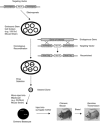Genetically manipulated mouse models of lung disease: potential and pitfalls
- PMID: 22198907
- PMCID: PMC4074003
- DOI: 10.1152/ajplung.00085.2011
Genetically manipulated mouse models of lung disease: potential and pitfalls
Abstract
Gene targeting in mice (transgenic and knockout) has provided investigators with an unparalleled armamentarium in recent decades to dissect the cellular and molecular basis of critical pathophysiological states. Fruitful information has been derived from studies using these genetically engineered mice with significant impact on our understanding, not only of specific biological processes spanning cell proliferation to cell death, but also of critical molecular events involved in the pathogenesis of human disease. This review will focus on the use of gene-targeted mice to study various models of lung disease including airways diseases such as asthma and chronic obstructive pulmonary disease, and parenchymal lung diseases including idiopathic pulmonary fibrosis, pulmonary hypertension, pneumonia, and acute lung injury. We will attempt to review the current technological approaches of generating gene-targeted mice and the enormous dataset derived from these studies, providing a template for lung investigators.
Figures


Similar articles
-
Genetically engineered mice in understanding the basis of neonatal lung disease.Semin Perinatol. 2006 Dec;30(6):341-9. doi: 10.1053/j.semperi.2006.09.001. Semin Perinatol. 2006. PMID: 17142160 Review.
-
Lung disease and PKCs.Pharmacol Res. 2007 Jun;55(6):545-59. doi: 10.1016/j.phrs.2007.04.010. Epub 2007 Apr 29. Pharmacol Res. 2007. PMID: 17582782 Review.
-
The a"MAZE"ing world of lung-specific transgenic mice.Am J Respir Cell Mol Biol. 2012 Mar;46(3):269-82. doi: 10.1165/rcmb.2011-0372PS. Epub 2011 Dec 28. Am J Respir Cell Mol Biol. 2012. PMID: 22180870 Free PMC article. Review.
-
Transgenic models for the study of lung biology and disease.Am J Physiol. 1994 Apr;266(4 Pt 1):L319-53. doi: 10.1152/ajplung.1994.266.4.L319. Am J Physiol. 1994. PMID: 8179011 Review.
-
Epigenetic targets for novel therapies of lung diseases.Pharmacol Ther. 2015 Mar;147:91-110. doi: 10.1016/j.pharmthera.2014.11.006. Epub 2014 Nov 15. Pharmacol Ther. 2015. PMID: 25448041 Free PMC article. Review.
Cited by
-
Comparison between cigarette smoke-induced emphysema and cigarette smoke extract-induced emphysema.Tob Induc Dis. 2015 Mar 25;13(1):6. doi: 10.1186/s12971-015-0033-z. eCollection 2015. Tob Induc Dis. 2015. PMID: 25814921 Free PMC article.
-
Niclosamide Attenuates Inflammation-Associated Profibrotic Responses in Human Subepithelial Lung Myofibroblasts.Biomedicines. 2023 Jul 19;11(7):2032. doi: 10.3390/biomedicines11072032. Biomedicines. 2023. PMID: 37509671 Free PMC article.
-
A critical review of the American Journal of Physiology-Lung Cellular and Molecular Physiology: 2012-2015.Am J Physiol Lung Cell Mol Physiol. 2014 Dec 15;307(12):L911-6. doi: 10.1152/ajplung.00330.2014. Epub 2014 Nov 7. Am J Physiol Lung Cell Mol Physiol. 2014. PMID: 25381028 Free PMC article. Review.
-
Animals in Respiratory Research.Int J Mol Sci. 2024 Mar 1;25(5):2903. doi: 10.3390/ijms25052903. Int J Mol Sci. 2024. PMID: 38474149 Free PMC article. Review.
-
The Mouse Lemur, a Genetic Model Organism for Primate Biology, Behavior, and Health.Genetics. 2017 Jun;206(2):651-664. doi: 10.1534/genetics.116.199448. Genetics. 2017. PMID: 28592502 Free PMC article. Review.
References
-
- Abe K, Toba M, Alzoubi A, Ito M, Fagan KA, Cool CD, Voelkel NF, McMurtry IF, Oka M. Formation of plexiform lesions in experimental severe pulmonary arterial hypertension. Circulation 121: 2747–2754, 2010. - PubMed
-
- Akram A, Han B, Masoom H, Peng C, Lam E, Litvack ML, Bai X, Shan Y, Hai T, Batt J, Slutsky AS, Zhang H, Kuebler WM, Haitsma JJ, Liu M, dos Santos CC. Activating transcription factor 3 confers protection against ventilator-induced lung injury. Am J Respir Crit Care Med 182: 489–500, 2010. - PMC - PubMed
-
- Albaiceta GM, Gutierrez-Fernández A, García-Prieto E, Puente XS, Parra D, Astudillo A, Campestre C, Cabrera S, Gonzalez-Lopez A, Fueyo A, Taboada F, López-Otin C. Absence or inhibition of matrix metalloproteinase-8 decreases ventilator-induced lung injury. Am J Respir Cell Mol Biol 43: 555–563, 2010. - PubMed
-
- Albaiceta GM, Gutiérrez-Fernández A, Parra D, Astudillo A, García-Prieto E, Taboada F, Fueyo A. Lack of matrix metalloproteinase-9 worsens ventilator-induced lung injury. Am J Physiol Lung Cell Mol Physiol 294: L535–L543, 2008. - PubMed
-
- Albiger B, Dahlberg S, Sandgren A, Wartha F, Beiter K, Katsuragi H, Akira S, Normark S, Henriques-Normark B. Toll-like receptor 9 acts at an early stage in host defence against pneumococcal infection. Cell Microbiol 9: 633–644, 2007. - PubMed
Publication types
MeSH terms
Grants and funding
LinkOut - more resources
Full Text Sources
Other Literature Sources
Medical

